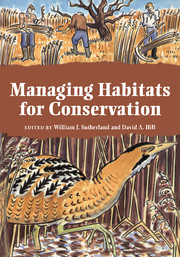Book contents
- Frontmatter
- Contents
- List of Contributors
- Acknowledgements
- 1 Introduction and principles of ecological management
- 2 Site management planning
- 3 Access
- 4 Coastal habitats
- 5 Rivers, canals and dykes
- 6 Waterbodies
- 7 Reedbeds, fens and acid bogs
- 8 Grasslands
- 9 Farmland
- 10 Lowland heathland
- 11 Upland moors and heaths
- 12 Woodland and scrub
- 13 Urban areas
- Some useful addresses
- Index of species by common names
- Subject index
10 - Lowland heathland
Published online by Cambridge University Press: 05 February 2015
- Frontmatter
- Contents
- List of Contributors
- Acknowledgements
- 1 Introduction and principles of ecological management
- 2 Site management planning
- 3 Access
- 4 Coastal habitats
- 5 Rivers, canals and dykes
- 6 Waterbodies
- 7 Reedbeds, fens and acid bogs
- 8 Grasslands
- 9 Farmland
- 10 Lowland heathland
- 11 Upland moors and heaths
- 12 Woodland and scrub
- 13 Urban areas
- Some useful addresses
- Index of species by common names
- Subject index
Summary
Introduction
Western European lowland heathland is a distinctive habitat found on nutrient-poor soils, particularly acidic podsols. Catastrophic losses of heathland have occurred throughout western Europe, through conversion to farmland, afforestation, urban development and succession. Despite large-scale losses of heathland in Britain, estimated at 75% between 1800 and 1983, c. 57 000 ha remain representing about 20% of the European resource (Farrell, 1989). Within Britain the survival of a number of species depends on lowland heathland, for example the Smooth Snake Coronella austriaca, Dartford Warbier Sylvia undata and numerous specialist invertebrates. Other rare species, such as Woodlark Lullula arborea, Nightjar Caprimulgus europaeus and Sand Lizard Lacerta agilis depend heavily on heathland but also breed in other habitats.
Lowland heathland communities
Lowland heathland communities found below 300 m are distinct from upland heather moorland. They are characterised by sandy mineral soils of generally lower nutrient status than moorland peat soils. Although we concentrate on ‘dwarf-shrub’ heathland dominated by heathers, particularly Heather or Ling Calluna vulgaris but also Erica species, and gorse (Ulex species), we also consider heathland habitat dominated by grasses and lichens. The ecological processes and land use practices which created and maintain these grass heath and liehen heath communities are the same as those which created and maintain dwarf-shrub heathland.
- Type
- Chapter
- Information
- Managing Habitats for Conservation , pp. 267 - 291Publisher: Cambridge University PressPrint publication year: 1995
- 5
- Cited by



